Yun Fu
SimpleCall: A Lightweight Image Restoration Agent in Label-Free Environments with MLLM Perceptual Feedback
Dec 21, 2025Abstract:Complex image restoration aims to recover high-quality images from inputs affected by multiple degradations such as blur, noise, rain, and compression artifacts. Recent restoration agents, powered by vision-language models and large language models, offer promising restoration capabilities but suffer from significant efficiency bottlenecks due to reflection, rollback, and iterative tool searching. Moreover, their performance heavily depends on degradation recognition models that require extensive annotations for training, limiting their applicability in label-free environments. To address these limitations, we propose a policy optimization-based restoration framework that learns an lightweight agent to determine tool-calling sequences. The agent operates in a sequential decision process, selecting the most appropriate restoration operation at each step to maximize final image quality. To enable training within label-free environments, we introduce a novel reward mechanism driven by multimodal large language models, which act as human-aligned evaluator and provide perceptual feedback for policy improvement. Once trained, our agent executes a deterministic restoration plans without redundant tool invocations, significantly accelerating inference while maintaining high restoration quality. Extensive experiments show that despite using no supervision, our method matches SOTA performance on full-reference metrics and surpasses existing approaches on no-reference metrics across diverse degradation scenarios.
LinkedOut: Linking World Knowledge Representation Out of Video LLM for Next-Generation Video Recommendation
Dec 18, 2025Abstract:Video Large Language Models (VLLMs) unlock world-knowledge-aware video understanding through pretraining on internet-scale data and have already shown promise on tasks such as movie analysis and video question answering. However, deploying VLLMs for downstream tasks such as video recommendation remains challenging, since real systems require multi-video inputs, lightweight backbones, low-latency sequential inference, and rapid response. In practice, (1) decode-only generation yields high latency for sequential inference, (2) typical interfaces do not support multi-video inputs, and (3) constraining outputs to language discards fine-grained visual details that matter for downstream vision tasks. We argue that these limitations stem from the absence of a representation that preserves pixel-level detail while leveraging world knowledge. We present LinkedOut, a representation that extracts VLLM world knowledge directly from video to enable fast inference, supports multi-video histories, and removes the language bottleneck. LinkedOut extracts semantically grounded, knowledge-aware tokens from raw frames using VLLMs, guided by promptable queries and optional auxiliary modalities. We introduce a cross-layer knowledge fusion MoE that selects the appropriate level of abstraction from the rich VLLM features, enabling personalized, interpretable, and low-latency recommendation. To our knowledge, LinkedOut is the first VLLM-based video recommendation method that operates on raw frames without handcrafted labels, achieving state-of-the-art results on standard benchmarks. Interpretability studies and ablations confirm the benefits of layer diversity and layer-wise fusion, pointing to a practical path that fully leverages VLLM world-knowledge priors and visual reasoning for downstream vision tasks such as recommendation.
MTS-DMAE: Dual-Masked Autoencoder for Unsupervised Multivariate Time Series Representation Learning
Sep 19, 2025
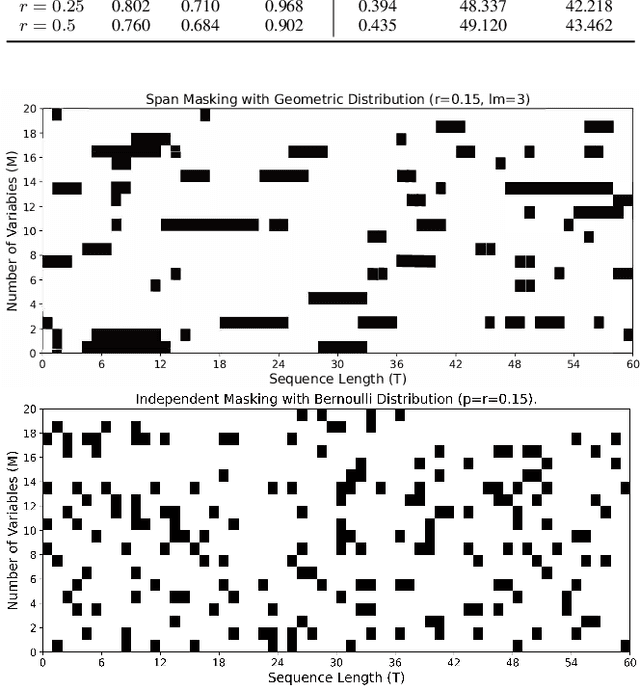
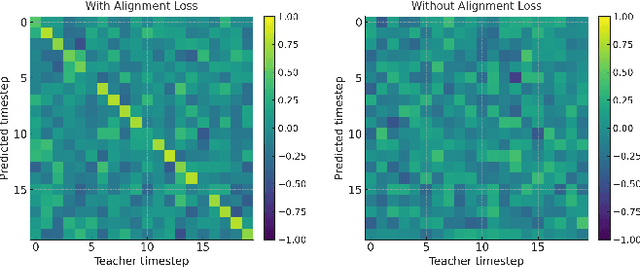
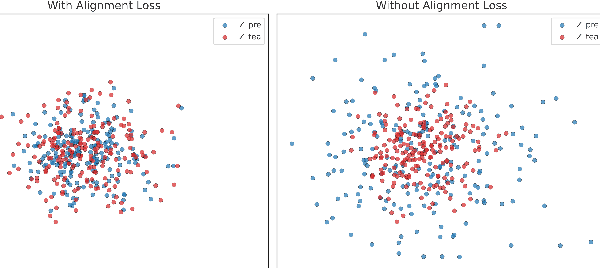
Abstract:Unsupervised multivariate time series (MTS) representation learning aims to extract compact and informative representations from raw sequences without relying on labels, enabling efficient transfer to diverse downstream tasks. In this paper, we propose Dual-Masked Autoencoder (DMAE), a novel masked time-series modeling framework for unsupervised MTS representation learning. DMAE formulates two complementary pretext tasks: (1) reconstructing masked values based on visible attributes, and (2) estimating latent representations of masked features, guided by a teacher encoder. To further improve representation quality, we introduce a feature-level alignment constraint that encourages the predicted latent representations to align with the teacher's outputs. By jointly optimizing these objectives, DMAE learns temporally coherent and semantically rich representations. Comprehensive evaluations across classification, regression, and forecasting tasks demonstrate that our approach achieves consistent and superior performance over competitive baselines.
AdaSports-Traj: Role- and Domain-Aware Adaptation for Multi-Agent Trajectory Modeling in Sports
Sep 19, 2025Abstract:Trajectory prediction in multi-agent sports scenarios is inherently challenging due to the structural heterogeneity across agent roles (e.g., players vs. ball) and dynamic distribution gaps across different sports domains. Existing unified frameworks often fail to capture these structured distributional shifts, resulting in suboptimal generalization across roles and domains. We propose AdaSports-Traj, an adaptive trajectory modeling framework that explicitly addresses both intra-domain and inter-domain distribution discrepancies in sports. At its core, AdaSports-Traj incorporates a Role- and Domain-Aware Adapter to conditionally adjust latent representations based on agent identity and domain context. Additionally, we introduce a Hierarchical Contrastive Learning objective, which separately supervises role-sensitive and domain-aware representations to encourage disentangled latent structures without introducing optimization conflict. Experiments on three diverse sports datasets, Basketball-U, Football-U, and Soccer-U, demonstrate the effectiveness of our adaptive design, achieving strong performance in both unified and cross-domain trajectory prediction settings.
Dense Video Understanding with Gated Residual Tokenization
Sep 18, 2025Abstract:High temporal resolution is essential for capturing fine-grained details in video understanding. However, current video large language models (VLLMs) and benchmarks mostly rely on low-frame-rate sampling, such as uniform sampling or keyframe selection, discarding dense temporal information. This compromise avoids the high cost of tokenizing every frame, which otherwise leads to redundant computation and linear token growth as video length increases. While this trade-off works for slowly changing content, it fails for tasks like lecture comprehension, where information appears in nearly every frame and requires precise temporal alignment. To address this gap, we introduce Dense Video Understanding (DVU), which enables high-FPS video comprehension by reducing both tokenization time and token overhead. Existing benchmarks are also limited, as their QA pairs focus on coarse content changes. We therefore propose DIVE (Dense Information Video Evaluation), the first benchmark designed for dense temporal reasoning. To make DVU practical, we present Gated Residual Tokenization (GRT), a two-stage framework: (1) Motion-Compensated Inter-Gated Tokenization uses pixel-level motion estimation to skip static regions during tokenization, achieving sub-linear growth in token count and compute. (2) Semantic-Scene Intra-Tokenization Merging fuses tokens across static regions within a scene, further reducing redundancy while preserving dynamic semantics. Experiments on DIVE show that GRT outperforms larger VLLM baselines and scales positively with FPS. These results highlight the importance of dense temporal information and demonstrate that GRT enables efficient, scalable high-FPS video understanding.
Out-of-Sight Trajectories: Tracking, Fusion, and Prediction
Sep 18, 2025Abstract:Trajectory prediction is a critical task in computer vision and autonomous systems, playing a key role in autonomous driving, robotics, surveillance, and virtual reality. Existing methods often rely on complete and noise-free observational data, overlooking the challenges associated with out-of-sight objects and the inherent noise in sensor data caused by limited camera coverage, obstructions, and the absence of ground truth for denoised trajectories. These limitations pose safety risks and hinder reliable prediction in real-world scenarios. In this extended work, we present advancements in Out-of-Sight Trajectory (OST), a novel task that predicts the noise-free visual trajectories of out-of-sight objects using noisy sensor data. Building on our previous research, we broaden the scope of Out-of-Sight Trajectory Prediction (OOSTraj) to include pedestrians and vehicles, extending its applicability to autonomous driving, robotics, surveillance, and virtual reality. Our enhanced Vision-Positioning Denoising Module leverages camera calibration to establish a vision-positioning mapping, addressing the lack of visual references, while effectively denoising noisy sensor data in an unsupervised manner. Through extensive evaluations on the Vi-Fi and JRDB datasets, our approach achieves state-of-the-art performance in both trajectory denoising and prediction, significantly surpassing previous baselines. Additionally, we introduce comparisons with traditional denoising methods, such as Kalman filtering, and adapt recent trajectory prediction models to our task, providing a comprehensive benchmark. This work represents the first initiative to integrate vision-positioning projection for denoising noisy sensor trajectories of out-of-sight agents, paving the way for future advances. The code and preprocessed datasets are available at github.com/Hai-chao-Zhang/OST
ExpertGen: Training-Free Expert Guidance for Controllable Text-to-Face Generation
May 22, 2025Abstract:Recent advances in diffusion models have significantly improved text-to-face generation, but achieving fine-grained control over facial features remains a challenge. Existing methods often require training additional modules to handle specific controls such as identity, attributes, or age, making them inflexible and resource-intensive. We propose ExpertGen, a training-free framework that leverages pre-trained expert models such as face recognition, facial attribute recognition, and age estimation networks to guide generation with fine control. Our approach uses a latent consistency model to ensure realistic and in-distribution predictions at each diffusion step, enabling accurate guidance signals to effectively steer the diffusion process. We show qualitatively and quantitatively that expert models can guide the generation process with high precision, and multiple experts can collaborate to enable simultaneous control over diverse facial aspects. By allowing direct integration of off-the-shelf expert models, our method transforms any such model into a plug-and-play component for controllable face generation.
Token-Shuffle: Towards High-Resolution Image Generation with Autoregressive Models
Apr 24, 2025Abstract:Autoregressive (AR) models, long dominant in language generation, are increasingly applied to image synthesis but are often considered less competitive than Diffusion-based models. A primary limitation is the substantial number of image tokens required for AR models, which constrains both training and inference efficiency, as well as image resolution. To address this, we present Token-Shuffle, a novel yet simple method that reduces the number of image tokens in Transformer. Our key insight is the dimensional redundancy of visual vocabularies in Multimodal Large Language Models (MLLMs), where low-dimensional visual codes from visual encoder are directly mapped to high-dimensional language vocabularies. Leveraging this, we consider two key operations: token-shuffle, which merges spatially local tokens along channel dimension to decrease the input token number, and token-unshuffle, which untangles the inferred tokens after Transformer blocks to restore the spatial arrangement for output. Jointly training with textual prompts, our strategy requires no additional pretrained text-encoder and enables MLLMs to support extremely high-resolution image synthesis in a unified next-token prediction way while maintaining efficient training and inference. For the first time, we push the boundary of AR text-to-image generation to a resolution of 2048x2048 with gratifying generation performance. In GenAI-benchmark, our 2.7B model achieves 0.77 overall score on hard prompts, outperforming AR models LlamaGen by 0.18 and diffusion models LDM by 0.15. Exhaustive large-scale human evaluations also demonstrate our prominent image generation ability in terms of text-alignment, visual flaw, and visual appearance. We hope that Token-Shuffle can serve as a foundational design for efficient high-resolution image generation within MLLMs.
GmNet: Revisiting Gating Mechanisms From A Frequency View
Mar 28, 2025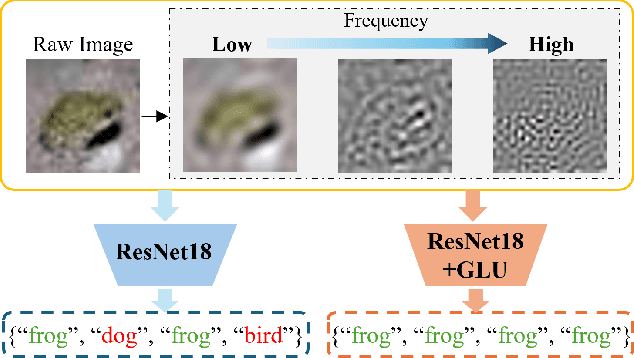

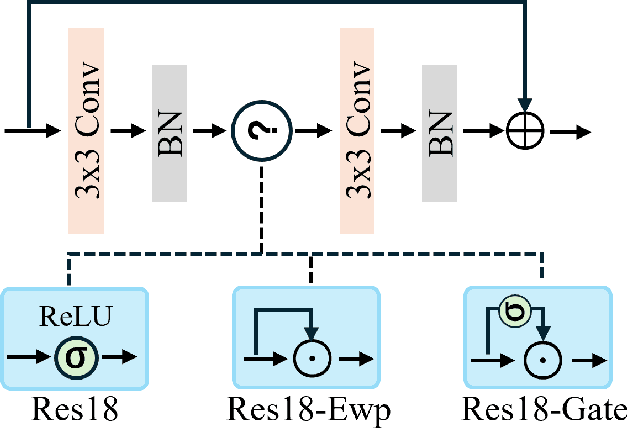
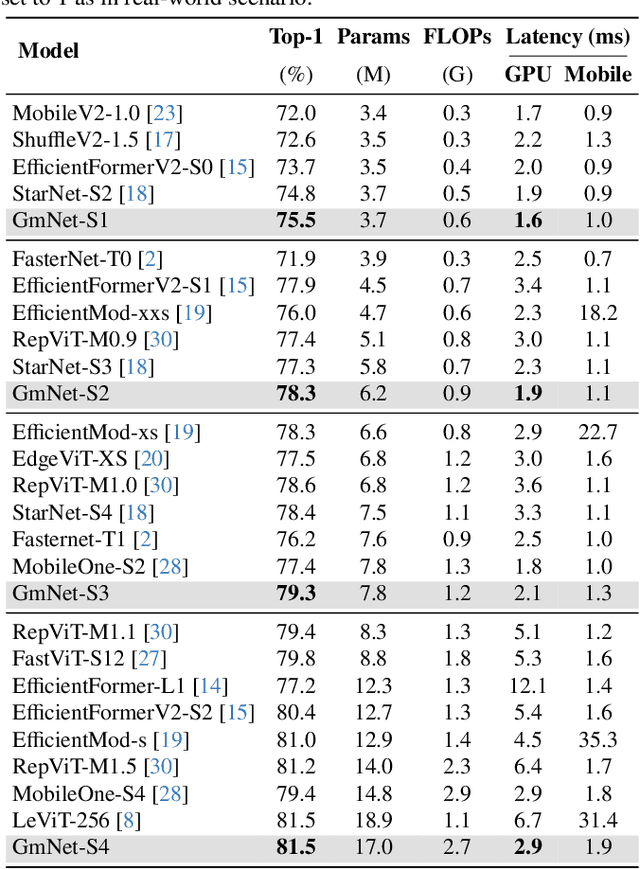
Abstract:Gating mechanisms have emerged as an effective strategy integrated into model designs beyond recurrent neural networks for addressing long-range dependency problems. In a broad understanding, it provides adaptive control over the information flow while maintaining computational efficiency. However, there is a lack of theoretical analysis on how the gating mechanism works in neural networks. In this paper, inspired by the {convolution theorem}, we systematically explore the effect of gating mechanisms on the training dynamics of neural networks from a frequency perspective. We investigate the interact between the element-wise product and activation functions in managing the responses to different frequency components. Leveraging these insights, we propose a Gating Mechanism Network (GmNet), a lightweight model designed to efficiently utilize the information of various frequency components. It minimizes the low-frequency bias present in existing lightweight models. GmNet achieves impressive performance in terms of both effectiveness and efficiency in the image classification task.
Boosting Large Language Models with Mask Fine-Tuning
Mar 27, 2025Abstract:The model is usually kept integral in the mainstream large language model (LLM) fine-tuning protocols. No works have questioned whether maintaining the integrity of the model is indispensable for performance. In this work, we introduce Mask Fine-Tuning (MFT), a brand-new LLM fine-tuning paradigm to show that properly breaking the integrity of the model can surprisingly lead to improved performance. Specifically, MFT learns a set of binary masks supervised by the typical LLM fine-tuning objective. Extensive experiments show that MFT gains a consistent performance boost across various domains and backbones (e.g., 1.95%/1.88% average gain in coding with LLaMA2-7B/3.1-8B). Detailed procedures are provided to study the proposed MFT from different hyperparameter perspectives for better insight. In particular, MFT naturally updates the current LLM training protocol by deploying it on a complete well-trained model. This study extends the functionality of mask learning from its conventional network pruning context for model compression to a more general scope.
 Add to Chrome
Add to Chrome Add to Firefox
Add to Firefox Add to Edge
Add to Edge